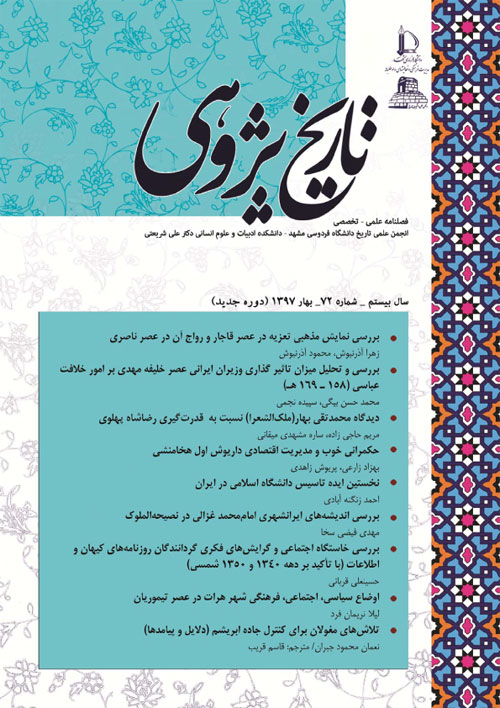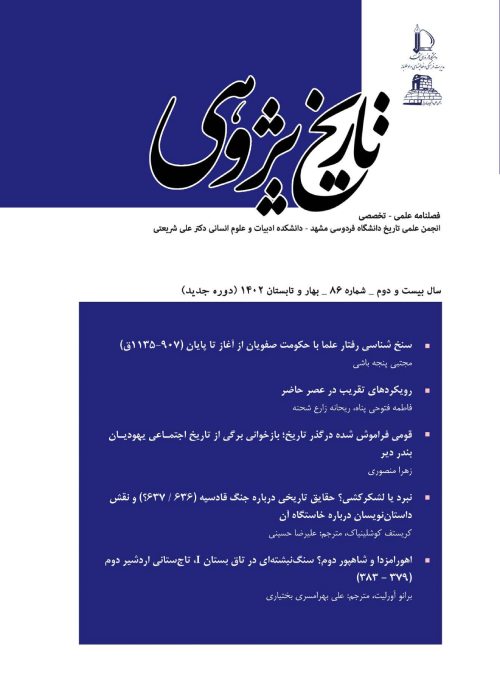فهرست مطالب

نشریه تاریخ پژوهی
پیاپی 72 (بهار 1397)
- تاریخ انتشار: 1397/06/22
- تعداد عناوین: 13
- مقالات
- ترجمه
- گزارش
- نقد کتاب
-
صفحه 243
-
Page 7The religious display of Taziye is one of the ancient cultural phenomenon in history of Iran which is known as one of the mourning ceremonies of Muharram in Shia culture. The history of this religious display dates back to the ancient period. Display of Taziye was of great importance in Qajar period. Qajar government, specially Naserodin Shah, payed a particular attention to this matter. In this period, Taziye was so significant to take the title of Golden Era of Taziye. The question is: What was the reason behind such a great progress of Taziye in Qajar era, especially in Naseri era? The study showed that the support and interest of court in the performance of Taziye and the policy that Naserodin Shah adopted to maintain a kind of tyranny in ceremonial dress, in performing Taziye and showing interest in the family of prophet Muhammad, and under the folk art in order to attract public attention in the society could be considered as one of the reasons. In this paper, in addition to the religious display of Taziye in Qajar period, the social and political reasons for turning to this art and its popularity will be examined.Keywords: Taziye, Qajariye, Naserodin Shah, Tekiye Dolat, Tyranny
-
Page 25The Abbasid caliph, Mahdi, reigned from 158-169 AH. The Mahdis era is known for its extensive reforms in the Islamic world and dealing with the difficulties of Abbasid caliphs Saffah and Mansur. Mahdi departed in manner from his father, Mansour, and gave more opportunity to courtiers and other companions for political tact. In Mahdis era, for the first time in the Muslim world, the ministry became official and three Iranian ministers, Muawiyah ibn Yasar, Yaqub ibn Dawud, and Aba-Jafar Feyz ibn Abi Salih, got this position. The present study seeks to investigate the role the Iranian ministers played in the era of Mahdi in the caliphates policies, and their efforts to attain the caliphate power. The main question is that to what extent the minister's influence was effective in the caliph Mahdis era? The assumption is that one of the aims of the Iranians in the court of Abbasid caliphate was to dominate the policies of the caliphate and to advance the demands of Iranian people. After the short-term ministry of the Abu Salamah during the Saffahs period and the coward ministry of Khalid Barmaki during the Mansours period, the Mahdis period should be considered as the starting point of the Iranians` influence on the Abbasid Caliphate bureaucracy.Keywords: Abbasi Caliphate, Mahdi, Ministry, Iranians
-
Page 45Reza Shah went into politics and became a king in one of the most critical periods. In the history of Iran, He marked an era when you can find many changes. Hence, he has been often examined based on the nature of his revolutionary actions at different stages of his domination over political and military institutions of Iran. Some individuals from the elite society, bureaucrats, parliamentarians, militants, Clergymen, and the press expressed different opinions and some conflicting opinions about Reza Shah. Mohammad-Taqi Bahar, widely known as Malek o-Shoarā, is one of the figures who has made some remarks about the rise of Reza Shah Pahlavi to power. The purpose of this study is to investigate Mohammad-Taqi Bahar's perspectives on Reza Shah Pahlavi and the potential changes of his opinion on Reza Shah through the written works and with focus on his political parties book and Divan poems using an explanatory-analytical method. The importance of this study lies in the fact that exploring remarkable figures` views such as Mohammad-Taqi Bahar on the events and developments of his time help us understand those events better and become familiar with the quality and quantity of the origin of Iranian economic, political and cultural developments occurring at that time.Keywords: Mohammad-Taqi Bahar (Malek O-Shoarā), Reza-Shah, Pahlavi, Qajar´S
-
Page 71Economic management is one of the most significant factors in a good governance and it could be considered as an indicator of the success of a government in any territory in history. The economic management of Darius I of Achaemenid received particular attention historically due to its unique factors. In this study, the literature of good governance, some definitions, and concepts are presented. Besides, it has been tried to examine the Dariush I of Achaemenids economic system using content analysis method and Delphi technique. The findings of this study show that Darius I's first steps were the basis for good governance in that period.Keywords: Good Governance, Economic Management, Darius I, Achaemenid, Economic Indicators
-
Page 91Although the establishment of Islamic University may be generally considered as the intellectual product of the Islamic Republic, it has been clear to the researchers that the idea is related to Pahlavi government in the early 1940s. A closer examination shows that the idea of the establishment of Islamic University can be found in an article published in Raad-e- emrooz newspaper in April 1944. Therefore, the idea was introduced two decades ago and the problem of this exploratory research, reviewing the idea of the establishment of Islamic University, was put forward 20 years before operating this plan. The method used is descriptive-analytical and the data collection was done through a Documentary method. In this study, the findings indicate that Mehdi Haeri, for the first time, presented the idea of Islamic University in Raad-e- emrooz newspaper (the official organ of the National Will Party). This idea was put forward to eliminate the moral degradation of all members in the ruling class.Keywords: Islamic University, Seyyed Ziaeddin Tabatabaei, Raade emrooz, Mehdi Haeri
-
Page 107Iranshahri's thought, as one of the concepts of the intellectual life of ancient Iran, has greatly reflected in various fields of culture and civilization, particularly in theorizing about political structures, in Iran during the Islamic period. Here, the ideas of thinkers, such as Imam Muhammad Al-Ghazali, who support the Seljuk government are worth considering. Imam Muhammad Al-Ghazali is a poet who follows this approach and has compiled Nasihat Al-Muluk book from compilations like the Ideal Kingdom, the Coherence of Religion, Government, and Justice. Despite advocating caliphate theory, supporting Abbasid Caliphs, and even compiling some books in this regard, Imam Muhammad Al-Ghazali stated a major part of his opinions regarding the Seljuk government based on Iranshahri's concepts. Although there are fundamental differences between Imam Muhammad Al- Ghazali` beliefs and Iranshahri's thoughts in the nature of some of the compilations like Justice, the concepts and elements included in the precepts transmitted to the Islamic period, especially in Ardashir Babakan or Time of Ardeshir book, deeply influenced the formation of Al-Ghazali's thoughts in the Nasihata Al-Muluk book.Keywords: Al-Ghazali, Nasihat Al-Muluk, Iranshahri's Thoughts, Seljuk
-
Page 129The press institutes of the Keyhan and Ettelaat, in addition to numerous newspapers, could publish many magazines to supply a large part of Iranian society. The two institutes hired a great number of journalists and media educators to cover all classes of society. The characteristics and attitudes of these members and other pillars of these two institutes, e.g., the members of editorial board, executive directors, and editors, are the major issues of the current study. The findings of this study indicate that they partly considered the western patterns in cultural domain. This was in line with the discussion of governmental modernism. The research method employed is descriptiveanalysis based on historical data.Keywords: Newspaper, Social Origin, Ettelaat, Keyhan
-
Page 161Timuriyan were successors of Mughal Ilkhanates. They reconstructed the destructions of mughal era. They also chose the east of Iran as their political center. Despite the struggles in Timuriyan era, we can see the progress in art and culture. Timur was interested in art and knowledge and this interest was continued through his successor era, Shahrokh, and next by Sultan Husayn Mirza Bayqara. The success of Shahrokh in choosing to have his capital in Harat led to a glamorous time in Harat in terms of culture, art, and architecture. Moreover, it caused principal changes by making cultural buildings such as libraries, mosques, and schools. In Timuriyan era, Harat was one of the big and important cities of Khorasan. The Khorasan Road and Silk Road played significant roles in the enhancement of Harat city. In this article, we seek to investigate the historical changes of Harat city, the factors affecting its enhancement and progress during Timuriyan era, and also study the events happening after cultural revolution in this period. The research questions are as the following: What are the reasons behind choosing Harat as the capital city in Timuriyan era?
What were the cultural and civil works done in Harat city?
Who was involved in cultural and civil works? To answer the abovementioned questions, the study continues with testing the hypotheses. Moreover, the documentary method is utilized to collect the data.Keywords: Harat, Timuriyan, Shahrokh, Silk Road, Architecture


